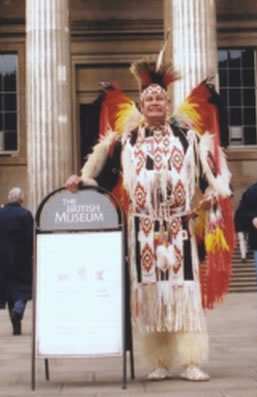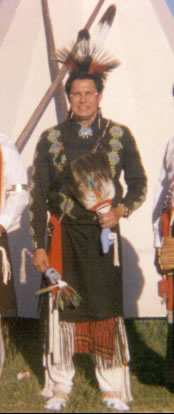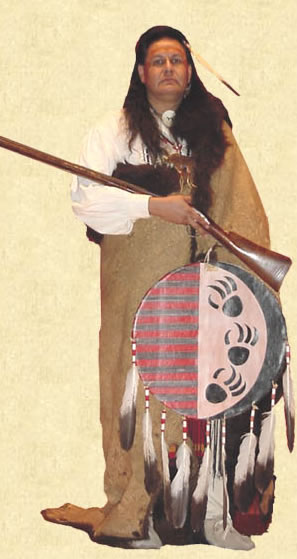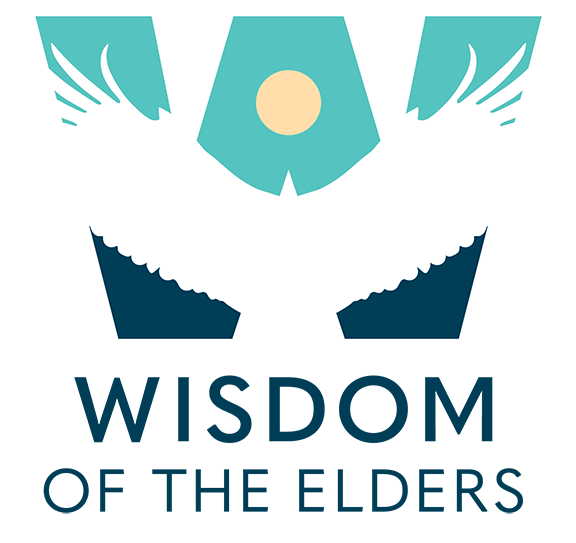Sayn Day, the Very First Man
 Greetings! My name is Dennis Zotigh. I belong to the Kiowa, Santee Dakota, and San Juan Pueblo tribes. I am an American Indian Research Historian for the Oklahoma Historical Society. I am also a consultant and lecturer. I’ve been involved in projects with the National Public Radio, National Geographic Magazine, ABC and NBC Television, the British Museum, and Nash Museum (National Museum of the American Indians).
Greetings! My name is Dennis Zotigh. I belong to the Kiowa, Santee Dakota, and San Juan Pueblo tribes. I am an American Indian Research Historian for the Oklahoma Historical Society. I am also a consultant and lecturer. I’ve been involved in projects with the National Public Radio, National Geographic Magazine, ABC and NBC Television, the British Museum, and Nash Museum (National Museum of the American Indians).
I’d like to give some examples of some of the stories that I tell in my presentations. I was the director of the Great American Indian Dance Company for over twenty years and we made presentations all over the world. The first example I would like to give of something that I would share with young people possibly K through grade 5, and this is a traditional story. I’m not going to give the stories in their entirety, but I’ll just give short excerpts.
This story comes from the Kiowa tribe and it involves their hero. His name is Sayn Day, and he was known as the very first man. Before you begin any Sayn Day story, you have to begin by saying, “Sayn Day on hail,” which means ‘Sayn Day was coming along’.
Well, let’s begin our story. Sayn Day on the hail. One day Sayn Day was coming along and he was looking for food because he was very hungry. “Oh, if I don’t find some food very soon I’ll surely perish out here in the wilderness.” So he sat on a log and he began to feel sorry for himself. When all of a sudden appeared something in the distance. “What’s that?” said Sayn Day. “It sounds like music. Wherever there’s music, there’s food.” That’s an example for young people.
I have an example of stories that I would tell age-appropriately to high school people. This is a story that they can relate to as it talks about Indian people today who have to learn to live in two worlds. This story is about a little Indian boy on his very first day of school.
This little Indian boy walked into class and he didn’t know all the other kids. So he looked around and he sat right in the front row and his teacher walked up to him and said, “Young man, can you tell me a little bit about yourself?” The shy little Indian boy looked down and he began to talk about himself. The teacher got very angry and stopped and said, “Young man, you’re not paying attention to me! Now, will you please start over and look at me in the eye before you speak?”
The little Indian boy began to talk again. As he began to talk his eyes went to the ground and his teacher stopped him and said, “Young man, I can see how you’re going to be a discipline problem from now on. Now I want you to get up out of your seat and go stand in the corner until you can learn to show me some respect by looking at me in the eye.”
 The little Indian boy got up out of his seat and he looked around, and all the other kids were laughing and pointing at him. He turned around very slowly and walked to the corner. When he got to the corner of the room big tears came down his eyes because he didn’t know what he was doing wrong.
The little Indian boy got up out of his seat and he looked around, and all the other kids were laughing and pointing at him. He turned around very slowly and walked to the corner. When he got to the corner of the room big tears came down his eyes because he didn’t know what he was doing wrong.
That’s an excerpt from the beginning of another story for high school-appropriate age. Now here is part of a lecture series about the pow wow, which is a movement that takes place all over the United States, Canada, and many parts of the world. This will be part of a lecture I would be giving about the pow wow.
Pow wow is a Narragansett word for the Algonquin language meaning ‘he dreams’. It was originally an Indian medicine man or priest who learned his art form ‘Pa-ua’ from his dreams. Pa-ua was formerly referred to in Plains Indian treaty documents in the 1870s. As American expansion moved west powwow became a term used to describe any type of Indian gathering, ceremony, or meeting. Eventually Indians learned the English language and accepted this definition used to describe their gatherings. This application has been functional up to the present-day pow wows we have today.
The Pa-ua may have originally had religious significance, but today’s pow wow does not present itself as a religious event. However, isolated songs, activities and articles worn by the dancers have actual spiritual significance. Modern pow wows are social events that are generally open to the public.
That’s the beginning of a lecture I would be giving. These are examples of what I would be able to offer, and hopefully, I will be able to visit many of you in the near future. Thank you very much. Aho!
Dennis W. Zotigh
American Indian Research Historian
Oklahoma Historical Society and Oklahoma Museum of History
 Dennis W. Zotigh is a Kiowa, San Juan Pueblo, and Santee Dakota Indian and resides in Oklahoma City, Oklahoma. He is a member of the Kiowa Gourd Clan and San Juan Pueblo Winter Clan, and a descendent of Sitting Bear and No Retreat, both principal war chiefs of the Kiowa.
Dennis W. Zotigh is a Kiowa, San Juan Pueblo, and Santee Dakota Indian and resides in Oklahoma City, Oklahoma. He is a member of the Kiowa Gourd Clan and San Juan Pueblo Winter Clan, and a descendent of Sitting Bear and No Retreat, both principal war chiefs of the Kiowa.
Zotigh began singing and dancing at native celebrations at a very young age. He grew up learning traditional values and has extended his capabilities as a cultural promoter by learning songs, dances, and their significance from indigenous nations across North America. With his wealth of knowledge, he has lectured at universities, museums, educational conferences, and symposiums both domestically and internationally on topics concerning American Indian culture. He is currently on the national speaking roster of The American Program Bureau.
He was the former director of the internationally known dance company, The Great American Indian Dancers. As a performer and lecturer, Zotigh has toured 49 states and 21 foreign countries. On March 4, 1999, under his direction, The Great American Indian Dancers were selected to perform for President Clinton at the 150th Anniversary of the Department of Interior in Washington, D.C. As both an Indian dancer and singer, he has competed and won numerous awards for his talents. He currently sings with the former world champion Indian singing group “The Zotigh Singers.” This popular singing group has hosted the singing for major powwows coast to coast. The Zotigh Singers have produced four CDs under the Indian House and Sweet Grass recording labels.
In 1990, he and his father revived a historical art form by founding the “World’s Championship Hoop Dance Contest,” held annually at the Heard Museum in Phoenix, Arizona. He has been Master of Ceremonies for three consecutive years at the “Miss Indian World Competition,” at the Gathering of Nations in Albuquerque, New Mexico in addition to serving various roles in numerous other Native American pageants and art events.
In 1991, he was commissioned to write a text encompassing American Indian dance titled, “MOVING HISTORY: The Evolution of the Powwow.” It is permanently housed and distributed by Oklahoma City’s Red Earth Center. This important piece of history has led to projects with The National Geographic Magazine, ABC and NBC Television, National Public Radio, The National Museum of the American Indian, The British Museum, and numerous publications.
He is also very active in his community and has served as Vice-President of the University of Oklahoma Indian Alumni Committee; a member of the Oklahoma City Mayor’s Indian Commission; The Mid-America Arts Alliance Multicultural Advisory Board, in Kansas City, Missouri; The Oklahoma Indian Affairs Commission’s Culture Arts Promotion Society; The Oklahoma City Indian Chamber of Commerce, The State Capitol Native American Celebration Committee; and an active executive board member of American Indian Broadcasting Inc., Oklahoma Folklife Council and cultural advisor for The Smithsonian National Museum of the American Indian. In addition, he has worked with the Oklahoma Children’s Theater to teach theater techniques using Native American themes.
Zotigh truly seeks to preserve the past, broaden how Native Americans are viewed in the present, and create new opportunities for Indian youth in the future.
Dennis Zotigh
PO Box 12291
Oklahoma City, OK 73157
405-759-2819
dzotigh@ok-history.mus.ok.us
